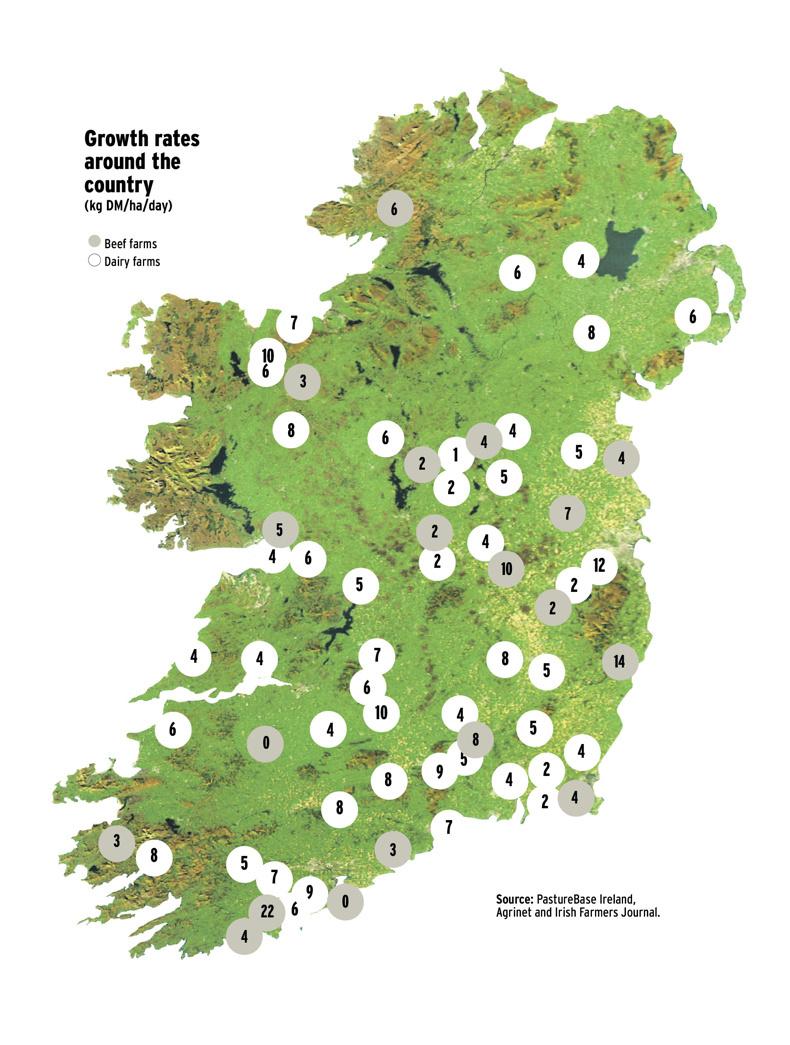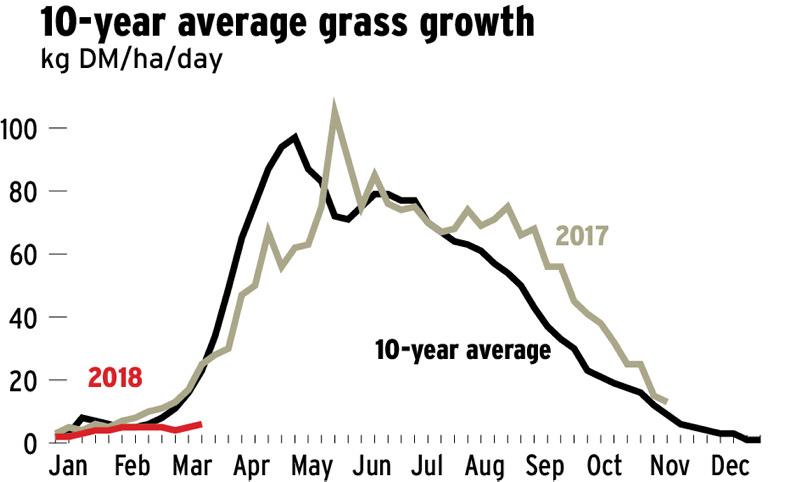This week last year, the Teagasc Pasturebase system recorded a national average growth rate in excess of 20kg DM/ha/day – yesterday the national figure was 5.4 on beef farms. However, many of Ireland’s beef farmers won’t be concerned with how grass is growing, more with how their land is drying out. Having travelled from east to west during the week visiting BETTER participants, it’s safe to say that there are as many, if not more animals out in the midlands/west than in the east on these farms. It must be added that these farmers have stock out on their driest fields or hillsides. Other areas remain wet and need drying before they can take stock.
Tuesday’s double-figure temperatures and sun will have done a lot to improve both ground conditions and farmers’ humours. However, today (Thursday) will see rain again and at the moment it looks like coastal areas in the west will bear the brunt of this in late afternoon. The rest of the country won’t be escaping though, with upwards of 10mm forecast generally.
In areas that escape the worst of the rain, the combination of dry weather earlier this week and some good days ahead should afford farmers the chance to turn out stock. If there’s grass there and ground is trafficable, go. Don’t be concerned about growth rates, not having enough grass to keep them out permanently or the fact that you haven’t got fertiliser spread. Outside, on spring grass in settled weather, is the place your cattle will thrive best. If they have to come back in, so be it. For some, every bale saved by getting out is invaluable. If you are concerned about fodder, turn to page 39 for some help. In terms of grazing, don’t rush to heavy covers unless your land is well dried out. Animals will grow restless trying to graze these out and might poach.
Fertiliser should be on all of our agendas. Yes, average soil temperatures are down, but these can shoot up in the space of a day if the right weather comes. Teagasc’s Páidi Kelly reported that 10cm temperatures rose from 1.7°C to 6.2°C in 12 hours on Tuesday. Spread when there are no heavy showers forecast for 48 hours. The response will come when conditions improve.


Co Limerick
System suckler to weanling
Soil type highly variable
Farm cover (kg DM/ha) 481
Demand (kg DM/ha/day) 3
Growth (kg DM/ha/day) 0
I have 29 yearlings at grass for the past week and have 10 cows with calves out. I will have another 15 out by the weekend. I am beginning my second round of grazing on my dry land and will hopefully begin grazing my wetter land in the coming week. I will turn yearling suckler heifers on to this land.
My out farm has good covers of grass and I will blanket spread 40 units per acre of urea on this very soon. Silage ground will be closed up as it is grazed off over the next week. I will spread 90 -100 units of urea/acre here. It received 2,500 gallons of slurry earlier in the spring.
Some of the low-index land will receive 0-7-30 at closing to provide adequate P & K for the crop. I plan to begin cutting mid-May and take fields out for bales as they come fit.
From April, all my low index land will receive two bags/acre of 18-6-12 after grazing. I may import some pig slurry also if available.

Co Donegal
System suckler to weanling
Soil type highly variable
Farm cover (kg DM/ha) 812
Demand (kg DM/ha/day) 0
Growth (kg DM/ha/day) 6
While spring has yet to really take off here, calving is well under way. Thankfully we have no major casualties to report to date. Growth is minimal but we have some nice covers to graze when ground conditions improve. Getting silage ground grazed off prior to closing is the plan at the minute. We have a light bunch of heifers earmarked for the job but we can let sheep clean it off if it remains on the soft side.
Fodder is tight in this part of the country but we have enough to see us out. Cows are in good condition and will remain on 1.5kg meal/head/day as we want them cycling for breeding in the coming weeks. Calves are beginning to fill out and scour hasn’t been an issue.
Slurry and fertiliser is out on the home block and while we haven’t seen a major response, the place has greened up. Under-16-month bulls will be slaughtered in the next week or two. All bulls have put on considerable flesh lately and we are happy they will meet carcase specifications.

Co Monaghan
System suckler to bull beef
Soil type highly variable
Farm cover (kg DM/ha) 729
Demand (kg DM/ha/day) 4
Growth (kg DM/ha/day) 4
I got eight days of grass into my cows and heifers with a zero-grazing machine during the dry period before the heavy snowfall. Since then it’s been back to grass silage. Ten of my 65 spring calving cows have calved to date and I am turning them out in groups of five to big fields with shelter. This is the best environment for calves. They go out for 24 hours once they’re sucking and strong. Otherwise, they would be sharing a building with all of my other stock and the chances of them picking something up are much higher. Ground conditions remain challenging and even these small groups are doing a small degree of damage to hillside fields.
On the plus side, I have seven Angus-sired bulls fit for slaughter and their performance has been excellent. They’re 13.7 months and their average weight is 643kg. This is a daily gain from birth of 1.44kg. I also run Simmental and Limousin bulls and use some continental AI and these animals will need longer to finish.

Co Meath
System suckler to bull beef
Soil type heavy clay
Farm cover (kg DM/ha) 893
Demand (kg DM/ha/day) 21
Growth (kg DM/ha/day) 7
There is a good cover of grass presently on the farm but the challenge is now getting out to graze it. I had a group of heifers out in February and they were rehoused before the snow and they only got back out again yesterday.
I got slurry out on my silage ground and the rest of the farm got over 30 units of urea/acre last week.
Calving is about to kick off. There are no calves on the ground as of yet but there are a few cows getting very close to it. Cows are currently on silage and those on the point of calving are getting hay as well as pre-calving minerals.
I am feeding a group of bulls that I purchased last autumn and they are doing very well. I drafted the first five for slaughter last week and I was very happy with how they did. I weighed my own spring-born weanlings last weekend and I grouped the heaviest of them for build-up on to ad-lib for finishing under 16 months.

Read more
Grass+ dairy: situation worsens as growth stagnates
This week last year, the Teagasc Pasturebase system recorded a national average growth rate in excess of 20kg DM/ha/day – yesterday the national figure was 5.4 on beef farms. However, many of Ireland’s beef farmers won’t be concerned with how grass is growing, more with how their land is drying out. Having travelled from east to west during the week visiting BETTER participants, it’s safe to say that there are as many, if not more animals out in the midlands/west than in the east on these farms. It must be added that these farmers have stock out on their driest fields or hillsides. Other areas remain wet and need drying before they can take stock.
Tuesday’s double-figure temperatures and sun will have done a lot to improve both ground conditions and farmers’ humours. However, today (Thursday) will see rain again and at the moment it looks like coastal areas in the west will bear the brunt of this in late afternoon. The rest of the country won’t be escaping though, with upwards of 10mm forecast generally.
In areas that escape the worst of the rain, the combination of dry weather earlier this week and some good days ahead should afford farmers the chance to turn out stock. If there’s grass there and ground is trafficable, go. Don’t be concerned about growth rates, not having enough grass to keep them out permanently or the fact that you haven’t got fertiliser spread. Outside, on spring grass in settled weather, is the place your cattle will thrive best. If they have to come back in, so be it. For some, every bale saved by getting out is invaluable. If you are concerned about fodder, turn to page 39 for some help. In terms of grazing, don’t rush to heavy covers unless your land is well dried out. Animals will grow restless trying to graze these out and might poach.
Fertiliser should be on all of our agendas. Yes, average soil temperatures are down, but these can shoot up in the space of a day if the right weather comes. Teagasc’s Páidi Kelly reported that 10cm temperatures rose from 1.7°C to 6.2°C in 12 hours on Tuesday. Spread when there are no heavy showers forecast for 48 hours. The response will come when conditions improve.


Co Limerick
System suckler to weanling
Soil type highly variable
Farm cover (kg DM/ha) 481
Demand (kg DM/ha/day) 3
Growth (kg DM/ha/day) 0
I have 29 yearlings at grass for the past week and have 10 cows with calves out. I will have another 15 out by the weekend. I am beginning my second round of grazing on my dry land and will hopefully begin grazing my wetter land in the coming week. I will turn yearling suckler heifers on to this land.
My out farm has good covers of grass and I will blanket spread 40 units per acre of urea on this very soon. Silage ground will be closed up as it is grazed off over the next week. I will spread 90 -100 units of urea/acre here. It received 2,500 gallons of slurry earlier in the spring.
Some of the low-index land will receive 0-7-30 at closing to provide adequate P & K for the crop. I plan to begin cutting mid-May and take fields out for bales as they come fit.
From April, all my low index land will receive two bags/acre of 18-6-12 after grazing. I may import some pig slurry also if available.

Co Donegal
System suckler to weanling
Soil type highly variable
Farm cover (kg DM/ha) 812
Demand (kg DM/ha/day) 0
Growth (kg DM/ha/day) 6
While spring has yet to really take off here, calving is well under way. Thankfully we have no major casualties to report to date. Growth is minimal but we have some nice covers to graze when ground conditions improve. Getting silage ground grazed off prior to closing is the plan at the minute. We have a light bunch of heifers earmarked for the job but we can let sheep clean it off if it remains on the soft side.
Fodder is tight in this part of the country but we have enough to see us out. Cows are in good condition and will remain on 1.5kg meal/head/day as we want them cycling for breeding in the coming weeks. Calves are beginning to fill out and scour hasn’t been an issue.
Slurry and fertiliser is out on the home block and while we haven’t seen a major response, the place has greened up. Under-16-month bulls will be slaughtered in the next week or two. All bulls have put on considerable flesh lately and we are happy they will meet carcase specifications.

Co Monaghan
System suckler to bull beef
Soil type highly variable
Farm cover (kg DM/ha) 729
Demand (kg DM/ha/day) 4
Growth (kg DM/ha/day) 4
I got eight days of grass into my cows and heifers with a zero-grazing machine during the dry period before the heavy snowfall. Since then it’s been back to grass silage. Ten of my 65 spring calving cows have calved to date and I am turning them out in groups of five to big fields with shelter. This is the best environment for calves. They go out for 24 hours once they’re sucking and strong. Otherwise, they would be sharing a building with all of my other stock and the chances of them picking something up are much higher. Ground conditions remain challenging and even these small groups are doing a small degree of damage to hillside fields.
On the plus side, I have seven Angus-sired bulls fit for slaughter and their performance has been excellent. They’re 13.7 months and their average weight is 643kg. This is a daily gain from birth of 1.44kg. I also run Simmental and Limousin bulls and use some continental AI and these animals will need longer to finish.

Co Meath
System suckler to bull beef
Soil type heavy clay
Farm cover (kg DM/ha) 893
Demand (kg DM/ha/day) 21
Growth (kg DM/ha/day) 7
There is a good cover of grass presently on the farm but the challenge is now getting out to graze it. I had a group of heifers out in February and they were rehoused before the snow and they only got back out again yesterday.
I got slurry out on my silage ground and the rest of the farm got over 30 units of urea/acre last week.
Calving is about to kick off. There are no calves on the ground as of yet but there are a few cows getting very close to it. Cows are currently on silage and those on the point of calving are getting hay as well as pre-calving minerals.
I am feeding a group of bulls that I purchased last autumn and they are doing very well. I drafted the first five for slaughter last week and I was very happy with how they did. I weighed my own spring-born weanlings last weekend and I grouped the heaviest of them for build-up on to ad-lib for finishing under 16 months.

Read more
Grass+ dairy: situation worsens as growth stagnates












 This is a subscriber-only article
This is a subscriber-only article















SHARING OPTIONS: